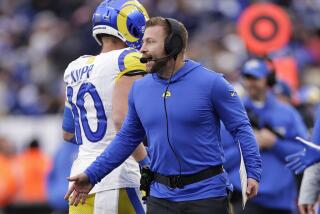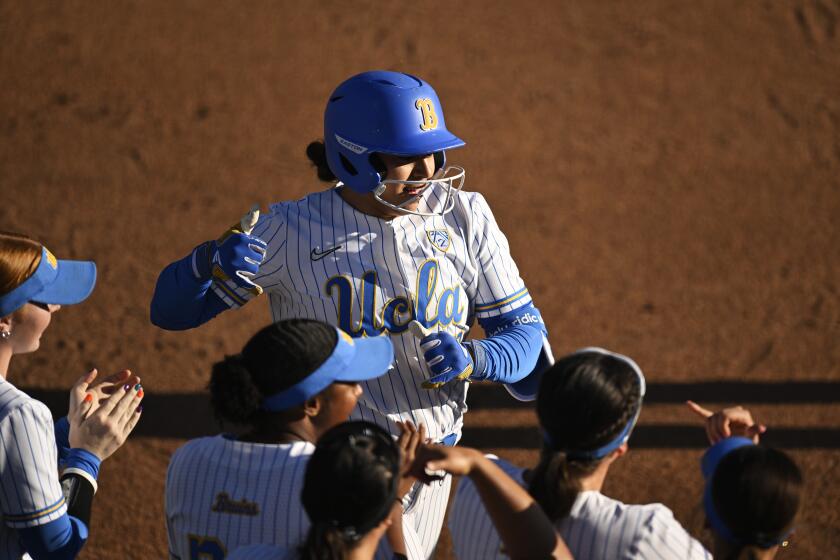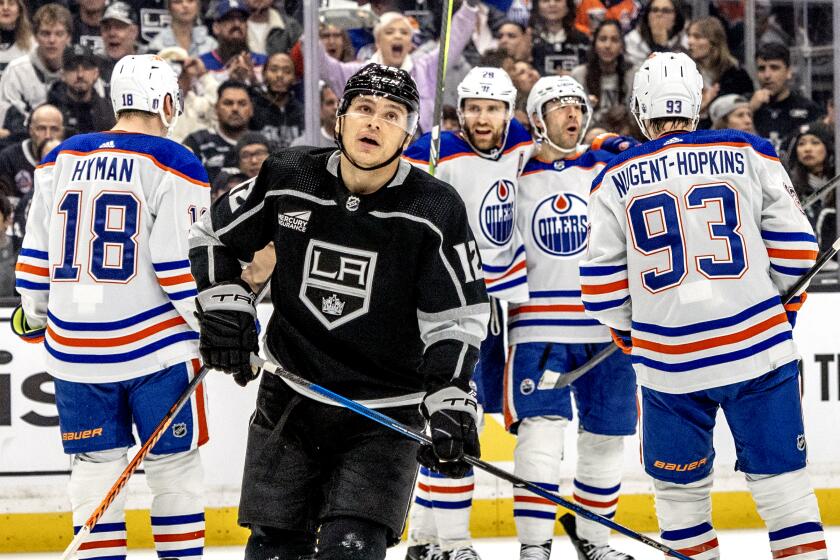NFL doesn’t want to go for the fake on injuries
No-huddle offense, meet the no-shame defense.
Were New York Giants defenders faking injuries Monday to slow the hurry-up offense of the St. Louis Rams?
Did San Diego do the same thing at New England on Sunday to throw Patriots quarterback Tom Brady off his rhythm?
Only those players can say for sure, but that was certainly a hot topic around the NFL on Tuesday.
The Giants example was most blatant. Late in the first quarter, after an eight-yard run moved the Rams to New York’s seven, safety Deon Grant and linebacker Jacquian Williams flopped to the ground in a comedic and almost simultaneous way. The game was stopped without the Giants having to spend a timeout.
“There is no question in my mind that that’s exactly the tactic they employed,” said former NFL quarterback Boomer Esiason, “Monday Night Football” analyst for Westwood One. “Interestingly enough, it worked.”
The drive stalled there, and the Rams — who ultimately lost, 28-16 — kicked a field goal.
“Well, from my standpoint on the sideline, I thought he was cramped,” Giants Coach Tom Coughlin said of Grant. “They were in a no-huddle situation and it was a hurry-up deal. I just thought he cramped at that time or definitely had something that was bothersome to him. When I looked down on the field, all I saw was the injured player.”
A similar situation happened in the Chargers-Patriots game Sunday, when San Diego linebacker Shaun Phillips seemed to suffer a phantom injury and slowed Brady’s hurry-up attack in the process.
Gamesmanship has been around as long as the game itself, and NFL history — as well football at lower levels — is littered with examples of players using feigned injuries to their advantage.
“I think we all see the way the game is now,” Patriots Coach Bill Belichick said Tuesday. “There are different breaks in the game at all points in time. You can have the momentum, the positive things going in your favor, and we stop and review a play, review a score, or a play gets challenged, or a player gets injured, a beach ball rolls out on the field.
“It could be a dog that runs out there. Streakers, you could have that.”
The league has taken some steps to address how injuries can affect the flow of a game. For instance, a team that has used all three timeouts receives a fourth if it needs to remove an injured player from the field. If that happens in the final two minutes of a half, the extra timeout results in a 10-second runoff of the clock if the injured player’s team is tied or trailing.
Faking still goes on. Even in cases when the intent seems obvious, officials are not in a position to decide whether an injury is real or staged. The league doesn’t want them making that determination, especially with the renewed emphasis on player safety. The league cannot take a hard-line stance, other than to say on Page 19 of the rule book: “The Competition Committee deprecates feigning injuries, with subsequent withdrawal, to obtain a timeout without penalty. Coaches are urged to cooperate in discouraging this practice.”
In an email, league spokesman Greg Aiello said “the action would be subject to discipline,” but only if a player or club admits it.
Good luck with that.
Rams Coach Steve Spagnuolo, former defensive coordinator of the Giants, said Tuesday he planned to send the play in question to the NFL for review, but said of officials: “They can’t make the decision of whether somebody’s hurt or not hurt. You just don’t know that. I don’t know. Part of the game, I guess.”
Esiason has his own experience with the tactic. He was quarterback of the Cincinnati Bengals in a 1989 playoff game against Seattle. Seahawks defensive tackles Joe Nash and Ken Clarke went down six times between them, coincidentally just as the Bengals were employing their no-huddle offense and conveniently allowing Seattle to get the desired defensive package on the field.
“Joe Nash said he had cramps, and I offered him some Midol in the middle of the game,” Esiason said with a laugh. “He was lying, and I don’t care what he says. I’ll never believe him, and I know that he was faking it 100%.”
Esiason said he recalled hearing the Seahawks had a signal from the sideline “where the coach would put his hand in the shape of a gun and kind of shoot the guy on the field, and then he would go down.”
But Esiason is among the many who believe the league cannot effectively legislate the practice.
“Even though it’s outside of the rules, and you’re pushing the envelope of ethics and things of that nature,” he said, “I’d probably be doing the same thing.”
twitter.com/LATimesfarmer
More to Read
Get our high school sports newsletter
Prep Rally is devoted to the SoCal high school sports experience, bringing you scores, stories and a behind-the-scenes look at what makes prep sports so popular.
You may occasionally receive promotional content from the Los Angeles Times.







